Using Markers for drawing and coloring is so much fun! They’re easy to use, come in more colors than you can imagine, and there’s not a lot of preparation involved in using them — just pick one up and get started!

Basic tips while using Markers:
- Line and wash: First do a line drawing in pen or ink. When it’s dry, add light washes with markers, watercolor or brush and ink. If the initial drawing is done in water-soluble ink, the wash will soften the ink lines, creating an interesting fusion of line and tone.
- Layering: Markers lend themselves perfectly to blending and layering color. Start with the lightest colors, building up rich layers of color and texture. Colorless blenders, such as those from Prismacolor and Chartpak, can be used to soften edges and combine colors.
- Combining media: Watercolor brush markers can be blended and lightened with a brush dipped in water or can be used in combination with traditional watercolor techniques.
-

New to using Crayons? Here are 7 crayons using techniques you need to know.
1. Use Different Nibs and Markers:
Different brands of markers will behave differently, so familiarize yourself with the different types of markers that are out there and the different types of nibs (tips) that they have. Different tips are good for different styles & techniques. Get a scratch piece of paper and try coloring in some squares to get a feel for how the different nibs work.
- Fine Point– good for close lines & details
- Brush Tip – Good for spreading ink smoothly in a manner similar to watercolor – flexible like a brush, softer lines
- Chisel / Broad Tip – Good for large area coverage

2. Color Slowly:
The best way to get even coverage and prevent streaks is to color slowly, unless you're going for a particular look and want the markers strokes to show.

3. Color from Light to Dark:
- START LIGHT! You can always add more color and go darker, but you can't go to the opposite way. Color in the lightest shades first, then build up darker colors.
- Try to plan out highlights in advance and know which areas you’re going to keep white (you can’t erase marker!)

4. Use Color Pencils :
Once you feel you’re at a good stopping point with the markers, use color pencils to add in final details and fine lines.

5. Color Testing :
Keep a separate sheet of the same type of paper you're working on next to you so you can test colors first before laying them down on your artwork.

6. Mandala Coloring:
Mandala Coloring Book is an activity that has been around for some time but is now growing in popularity with the mainstream. It provides stress relief, Meditative Art, entertainment, and is just plain fun. The act of colouring has a profound brain-quieting, calming impact on professionals who otherwise might have a hard time relaxing.The ideal markers for colouring mandalas will be comfortable to hold for long periods of getting lost in your projects, will offer bleed-free, non-toxic ink, and will create lasting, vibrant color.

7. Zentangle Coloring:

With the right materials, techniques and information in hand, you are well on your way to drawing with markers and ink like a pro. If you want to know more about other media, refer these link below:
Color Pencil Using Techniques for Beginners
Crayons Using Techniques for Beginners
Felt Tip Pens Using Techniques for Beginners
Oil Pastel Using Techniques for Beginners
Glitter Pens Using Techniques for Beginners
Brush Pens Using Techniques for Beginners
Pencil Shading Using Techniques for Beginners
Charcoal Pencil Using Techniques for Beginners
Oil Painting Using Techniques for Beginners
Acrylic Painting Using Techniques for Beginners
Gouache Using Techniques for Beginners
To explore our Coloring Books





